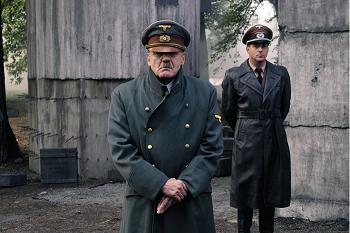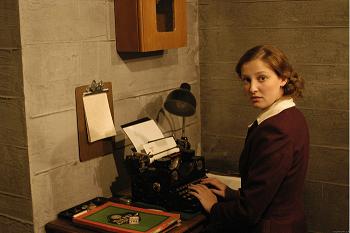

Is it possible to humanize Hitler without detracting from his great evils? This is one of the controversies that surrounded the Academy Award nominated Downfall (it lost to Spain's The Sea Inside) when it bowed in Germany. He was obviously a monster. But by showing him as human, can it engender sympathy towards him? After watching Downfall, the answer is no. Downfall is an enthralling look at the last days of the Third Reich, and shows a paranoid, delusional Hitler still trying to grasp onto what little he has left. By portraying him as human, the filmmakers do not end up evoking sympathy for him. They do provide a slightly better understanding of why he did what he did, relative to his actions in his bunker. At the heart of this is a riveting performance by Bruno Ganz (The Manchurian Candidate, Luther).
The main image people have of Hitler is from old newsreels, where he is a ranting, raving lunatic. Ganz gives a more multifaceted role. He does spew out invectives, but Downfall shows him in other settings; in his office, or with his wife. Here, he seems almost 'normal,' which actually makes his character all the more frightening. Downfall, based on the book Inside Hitler's Bunker by Joachim Fest and Until the Final Hour by Traudl Junge and Melissa Muller, tells its story through the eyes of Junge (Alexandra Maria Lara, Naked, 99 Euro Films), Hitler's secretary (recently the subject of the film Blind Spot). The film begins in 1942, when Junge takes on the job as secretary, and moves forward to 1945, when the Soviets where beginning to overtake Berlin.
Director Oliver Hirschbiegel (Das Experiment, Mortal Friends) and adapter Bernd Eichinger (The Devil and Mrs. D, Canossa) go for scope. In addition to Hitler, Junge, and the others in the bunker, Hirschbiegel spends time on the dangerous streets of Berlin. Nazis indiscriminately execute citizens for sympathizing with Soviets, and children fire rockets at tanks. Dr. Ernst-Gunter Schenk (Christian Berkel, Safe Conduct, Das Experiment) treats an endless amount of wounded soldiers and civilians with dwindling supplies. This contrasts greatly with events in the bunker, where Hitler, Eva Braun (Juliane Kohler, Nowhere in Africa, Aimee and Jaguar) and other dine on fine china.
Events in the bunker show how out of touch with reality Hitler was. All of his aides and generals know that they are losing badly. They entreat Hitler to leave Berlin, but Hitler refuses. He is under the illusion that his depleted battalions are at full strength, and commands them to make impossible moves to fight against the Allies. Because of the ardent loyalty he engenders, Junge and others refuse to leave him. Conditions continue to get desperate, and as the Soviets make their way into Berlin, everybody, especially Hitler, knows that the end is near. The bunker is like a large tomb for them. By continually showing events above the bunker, Hirschbiegel shows how these events influenced Hitler's thinking and makes it more plausible to explain why he eventually committed suicide. It also seems like he went to great pains to be as historically accurate as possible. The film is full of historical characters, some of which have little to say, but Hirschbiegel does show what happened to them after the war.